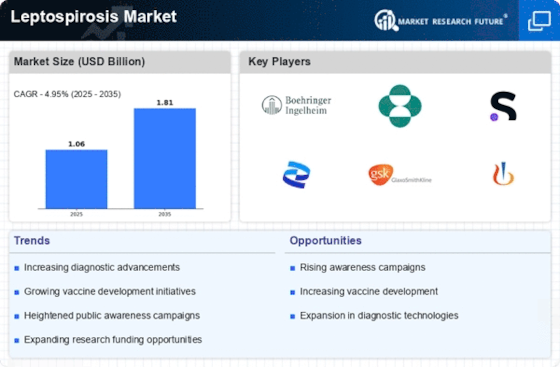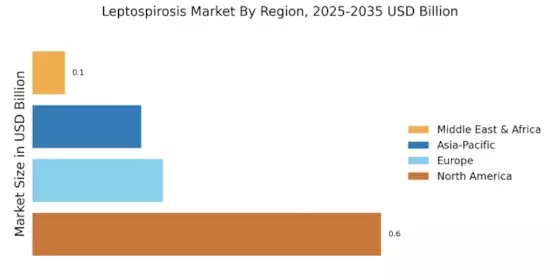Rising Veterinary Concerns
The increasing incidence of Leptospirosis in animals is another significant driver for the Leptospirosis Market. As the disease can be transmitted from animals to humans, veterinary health plays a crucial role in controlling its spread. The rise in reported cases among pets and livestock has prompted veterinarians to advocate for vaccination and preventive measures. This heightened awareness among pet owners and farmers is likely to drive demand for veterinary vaccines and treatments, thereby expanding the market. Furthermore, collaboration between veterinary and human health sectors is expected to enhance surveillance and control efforts, ultimately benefiting the Leptospirosis Market.
Growing Public Health Awareness
Growing public health awareness regarding Leptospirosis is a pivotal driver for the Leptospirosis Market. Increased media coverage and educational campaigns have led to a better understanding of the disease and its transmission routes. As communities become more informed about the risks associated with Leptospirosis, there is a corresponding rise in demand for preventive measures, such as vaccinations and hygiene practices. This trend is likely to encourage healthcare providers to invest in educational resources and preventive strategies, further propelling the market. Additionally, partnerships between public health organizations and community groups are expected to enhance outreach efforts, thereby fostering a more proactive approach to managing Leptospirosis within the population.
Government Initiatives and Funding
Government initiatives aimed at controlling and preventing Leptospirosis significantly influence the Leptospirosis Market. Various health authorities are implementing programs to raise awareness, improve sanitation, and enhance surveillance of the disease. For instance, funding for research and development of vaccines and diagnostic tools is increasing, as governments recognize the public health threat posed by Leptospirosis. This financial support is likely to foster innovation within the market, leading to the introduction of new products and technologies. Additionally, public health campaigns are expected to educate communities about prevention measures, further driving the demand for related healthcare solutions in the Leptospirosis Market.
Increasing Incidence of Leptospirosis
The rising incidence of Leptospirosis is a critical driver for the Leptospirosis Market. Reports indicate that the disease is becoming more prevalent in various regions, particularly in tropical and subtropical areas. This increase is attributed to factors such as climate change, urbanization, and inadequate sanitation. As the number of reported cases rises, healthcare systems are compelled to enhance their diagnostic and treatment capabilities. Consequently, this trend is likely to stimulate demand for vaccines and therapeutics, thereby expanding the Leptospirosis Market. Furthermore, the World Health Organization has noted a concerning rise in cases, which may lead to increased funding and research initiatives aimed at combating this infectious disease.
Technological Advancements in Diagnostics
Technological advancements in diagnostic methods are transforming the Leptospirosis Market. The introduction of rapid diagnostic tests and molecular techniques has improved the accuracy and speed of Leptospirosis detection. These innovations enable healthcare providers to diagnose the disease more effectively, which is crucial for timely treatment and management. As a result, the demand for advanced diagnostic tools is likely to surge, contributing to market growth. Moreover, the integration of digital health technologies, such as telemedicine, is facilitating access to diagnostic services, particularly in remote areas. This trend indicates a promising future for the Leptospirosis Market, as enhanced diagnostics lead to better patient outcomes.



















Leave a Comment